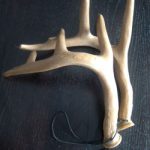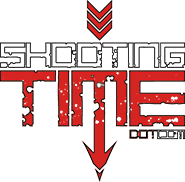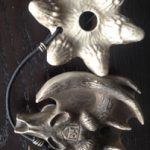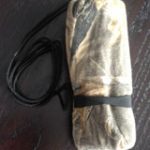 When whitetail bucks are establishing dominancy and seeking does for breeding, they may respond to deer rattling. Deer rattling is the simulation of two or more white tail bucks that are engaged in a fight. Many sounds are made when two whitetail bucks are fighting.
When whitetail bucks are establishing dominancy and seeking does for breeding, they may respond to deer rattling. Deer rattling is the simulation of two or more white tail bucks that are engaged in a fight. Many sounds are made when two whitetail bucks are fighting.
These sounds include the following:
- Antlers smacking together
- Aggressive grunts and snort wheezes
- The rustling of fallen leaves and the breaking of branches and other vegetation
These sounds can be heard from a great distance. When bucks within range hear these sounds, it may trigger them into action and if it does, look out!
Deer rattling success factors
Deer location
Deer rattling success is comparable to hunting coyotes with an electronic caller in my opinion. You have to access your hunting area undetected; so that means that your targeted buck(s) can not be within immediate (hearing and scenting) range. The bucks do, however, have to be in hearing range of your rattling.
Frequency of deer rattling
As previously stated, if you arrived at your hunting location in a quiet manner, you can start rattling. After a couple of minutes of rattling, stop and be on the look out. A buck within hearing range of rattling will not take long to find you. If you don’t see a buck within 10 minutes, its safe to say that either there were no deer in audio range or the bucks are just not responding aggressively to rattling yet. They still may get curious and take their time reaching and researching your location, so its best to always be ready.
After the first unsuccessful attempt at deer rattling, its important to allow enough time for deer to enter the audio range. Audio range for an aggressive rattle can be up to 1/2 of a mile. We suggest waiting at least an hour or more to start the next rattling sequence.
Hunting pressure in your area
Too much hunting pressure will drive down success rates wherever you hunt. Hunters educate deer. While young deer may get fooled often due to their curious nature, older deer are wiser. Older deer (trophy bucks) have witnessed many rattling attempts by hunters and proceed with extreme caution. The success of deer rattling on private land vs public land is drastic.
Shootingtime.com deer rattling tip
If you want to rattle where the hunting pressure is high, make sure you are perfect in your execution and try some outside of the box techniques. One technique is to rattle in the early morning when its still dark. Still dark you say? Yes, just before there’s enough light to see your pins. Educated deer may be fooled by this and enter your area investigating the sounds. Remember, they are used to hunters rattling deer during daylight and may drop their guard thinking its a real fight. Once they are in your area and ten minutes pass, you’ll have enough light enabling you a shooting opportunity.
Establish the perfect environment and get ready
Setup a reassuring environment
Remember that you are simulating two or more live bucks that are fighting. They grunt and they stink of strong tarsal glands. If you have fresh buck tarsal scent and have a grunt call, you can create a realistic environment that won’t alarm responding bucks. It doesn’t hurt to have a decoy or two out as well for visual reassurance.
If you rattle, peak the curiosity of a nearby buck, and give him a reassuring environment to walk into, your may just get the perfect shot at him.
Rattle, stop, then quickly grab your bow.
If bucks are responding in your area, you have to make sure that you are ready for their arrival. This means be ready. Rattle and put down your rattling device quickly and get ready. No one wants to be surprised by a big ole buck while holding rattling antlers!
What to use for deer rattling
What you use is really up to personal preference. Its a delicate balance between sounding authentic and not being seen while rattling. The following are some systems to try out.
Real antlers
Real antlers offer, by far, the best sound when deer rattling. You can use different sizes for different scenarios. Use your largest set of antlers for the rut. Use smaller antlers for prerut and less aggressive situations.
Synthetic antlers
Smaller items like rattle bags and rattle devices like Knight and Hale’s Da Bone Head allow for good quality rattle sounds while allowing the deer hunter to be less visible while rattling. Synthetic antlers do work but we think if you can get away with using the real deal, you will sound better.
When and how should you rattle
Early Season
If you are going to try deer rattling in the early season (yes, some hunters do), try using smaller antlers and tap the antlers together lightly, imagining younger bucks ticking and tapping; sort of as a greeting rather than a challenge. Remember that you are trying to peak curiosity with realistic behavior and the deer in the early season are not aggressive.
Prerut, Rut, and Post Rut
During the prerut and rut, bucks are naturally engaged in fighting activity. This is the time you want to put on your best rattling show. We advise rattling from a moderate to aggressive level. If the bruisers of the land want to be crown as king of your area and you set a proper stage, you may get a shot at that trophy of a lifetime.
Post rut deer rattling can be effective as well. This is due to the fact that not all does come into heat at the same time and some are left unbred after the first rut. When there are does to be bred, there will be competition between the bucks resulting in successful deer rattling.
Where should you rattle?
- Deer rattling around active scrapes works very well. Make mock scrapes with products that you can purchase if you don’t locate any active scrapes.
- Always try to scout the areas you intend to hunt. I know not everyone has time to scout unfortunately, but you can increase your luck by looking at a map of the area and hunt in a tree stand or blind close to thickets, funnels, near a creek, fence lines, and places with signs of buck activity.
- Learn about weather and wind when hunting. No matter what you use to be scent-free, you will never fool a deer’s nose. Check the winds and always hunt knowing the direction of the wind. No rattling technique will work if they can smell you from a distance. If you are after a big buck, you know they get big from being leery and smart.
Learn from other hunter’s success
There are definitely different techniques that have worked for some, and not for others. That is not to say one technique is better than another. The point is not to give up when a buck doesn’t show up – just stick with it and keep trying. Most people don’t get a buck in and become impatient, and just plain give up. Have patience!
- Using buck lures and scents with your rattling enhances the realism of your rattling technique.
- Grunting with a buck grunt call in between rattling can add to the effect.
- Start out with some clicking noises; then build up the rattling and make it louder. Then switch it up and start loud.
- Scrape the antlers against some brush for another realistic touch.
- Grind the antlers back and forth, pull them apart and then hit them together again.
- Hit the antlers on the ground if you’re not in a tree stand, and then bang them together again.
- Make some noise in between by hitting tree limbs or bushes.
- Imagine you are two bucks fighting or locked up and make it sound as real as possible
- Hit the antlers together hard and make it loud, and grind them back and forth, twist them together, and pull them apart and hit them together again, using different variations.
- Change to a lighter, quieter rattling occasionally to heighten the buck’s curiosity.
- You can rattle as long as a half a minute or longer and how often to rattle seems to be an individual thing. Certain hunters rattle every 5-10 minutes, and some say every 20 minutes to up an hour in between. Some hunters do rattle all day around the rutting period.
- If a buck runs off, it won’t hurt try to rattle louder to bring him back.
- Try using decoys while rattling deer.
Your own experience will fine tune your approach for you. Study your hunting log from previous years to see when you had success and concentrate on that calendar period. After years of deer rattling and studying results, you will ultimately gain knowledge of the best technique to use and hopefully bag some nice trophies!


